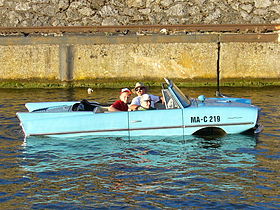Amphicar
| Amphicar Model 770 | |
|---|---|

Amphicar Model 770 photographed in Stuttgart 2005
|
|
| Overview | |
| Manufacturer | Quandt Group |
| Production | 1961-1968 4,000 built |
| Designer | Hanns Trippel |
| Body and chassis | |
| Body style | two door cabriolet with boat features |
| Layout | RR layout |
| Powertrain | |
| Engine | 1147 cc straight-4 (Triumph) |
| Transmission | 4-speed all-synchromesh manual |
| Dimensions | |
| Wheelbase | 84 in (2,134 mm) |
| Length | 171 in (4,343 mm) |
| Width | 62 in (1,575 mm) |
| Height | 60 in (1,524 mm) |
| Curb weight | 2,324 lb (1,054 kg) |
The Amphicar Model 770 is an amphibious automobile, launched at the 1961 New York Auto Show, manufactured in West Germany and marketed in the United States from 1961-1967, with production having ended in 1965.
Designed by Hanns Trippel, the amphibious vehicle was manufactured by the Quandt Group at Lübeck and at Berlin-Borsigwalde, with a total of 3,878 manufactured in a single generation.
A descendant of the Volkswagen Schwimmwagen, the Amphicar offered only modest performance compared to most contemporary boats or cars, featured navigation lights and flag as mandated by Coast Guard — and after operation in water, required greasing at 13 points, one of which required removal of the rear seat.
The Amphicar name is a portmanteau of "amphibious" and "car".
Engine: Triumph four-cylinder engine of 1147 cc, 8.0 compression ratio, rated at 38.3 bhp
Chassis/body
Appearance
Front undersurface is slightly pointed and sharply cut away below. The wheels are set low, so that the vehicle stands well above ground level when on dry land. Front and rear bumpers are placed low on the body panels (but fairly high in relation to dry ground). The one-piece windshield is curved. The foldable top causes the body style to be classified as cabriolet. Its water propulsion is provided by twin propellers mounted under the rear bumper. The Amphicar is made of mild steel.
The Amphicar's engine was mounted at the rear of the craft, driving the rear wheels through a 4-speed manual transmission. For use in the water, the same engine drove a pair of reversible propellers at the rear, with a second gear lever engaging forward or reverse drive. Once in the water, the main gear lever would normally be left in neutral. By engaging first gear as well as drive to the propellers when approaching a boat ramp, the Amphicar could drive itself out of the water.
...
Wikipedia
